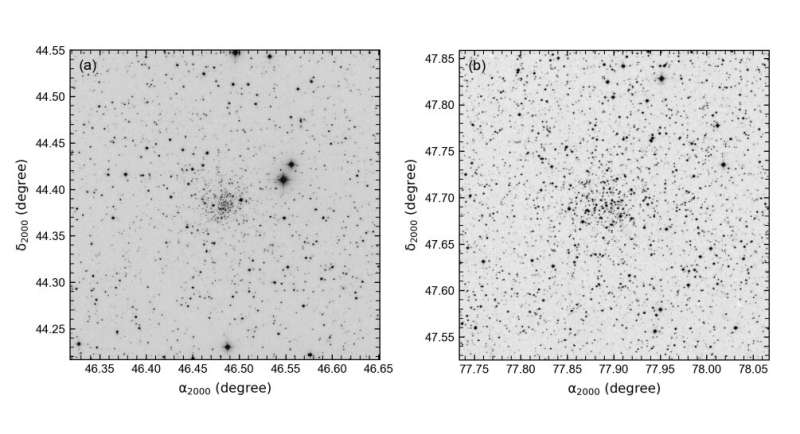
Using the San Pedro Martir Observatory and data from ESA’s Gaia satellite, astronomers have inspected two old open clusters (OCs) known as NGC 1798 and NGC 1193. Results of the study, published July 13 on the arXiv pre-print server, shed more light on the properties of these OCs.
OCs, formed from the same giant molecular cloud, are groups of stars loosely gravitationally bound to each other. So far, more than 1,000 of them have been discovered in the Milky Way, and scientists are still looking for more, hoping to find a variety of these stellar groupings. Expanding the list of known galactic OCs and studying them in detail could be crucial for improving our understanding of the formation and evolution of our galaxy.
Discovered in 1885, NGC 1798 is located some 11,300 light years away, in the constellation Auriga. It has a metallicity at a level of -0.27 and its age is estimated to be 1.7 billion years. When it comes to NGC 1193, this OC was discovered in 1786 in the constellation of Perseus, at a distance of about 15,000 light years from the Earth. Previous observations have found that NGC 1193 is approximately 8 billion years old, and has a metallicity at a level of -0.34.
A group of researchers led by Talar Yontan of the Istanbul University in Turkey performed a photometric, astrometric, and kinematic study of the two OCs with the San Pedro Martir Observatory. The research was complemented by data from Gaia Early Data Release 3 (EDR3).
“The observations of these two clusters, along with many others, were carried out at the San Pedro Martir Observatory, as part of an ongoing UBVRI photometric survey of Galactic stellar clusters. The 84-cm (f /15) Ritchey-Chretien telescope was employed in combination with the Mexman filter wheel,” the researchers explained.
In general, the observations allowed the team to examine the structure of NGC 1798 and NGC 1193. They obtained basic astrophysical parameters as well as properties of galactic orbits for these two clusters.
The study found that both clusters have limiting radii of approximately 8 arcminutes. This value corresponds to limiting radii of 33.77 and 42.21 for NGC 1798 and NGC 1193, respectively. The astronomers noted that they consider the stars within these limiting radii as potential cluster members and restricted their analysis to this set of stars.
All in all, the researchers identified 428 and 361 stars as most likely members of NGC 1798 and NGC 1193, respectively. It was found that both OCs were born outside the solar circle with the birth radii of 35.4 light years for NGC 1193 and 38.5 light years for NGC 1798 from the Galactic center. Moreover, both clusters orbit in the metal-poor region of the Galactic disk.
According to the new findings, NGC 1798 has a reddening of 0.5 mag and photometric metallicity at a level of -0.2. The cluster turned out to be younger than previously thought as its age was calculated to be about 1.3 billion years. The distance to NGC 1798 was measured to be 14,500 light years.
When it comes to NGC 1193, its reddening is approximately 0.15 mag, while its metallicity was determined to be -0.3. This OC is located about 18,100 light years away and was also found to be younger than previously estimated—its age turned out to be 4.6 billion years.
Explore further
T. Yontan et al, A study of the NGC 1193 and NGC 1798 open clusters using CCD UBV photometric and Gaia EDR3 data. arXiv:2207.06407v1 [astro-ph.GA], arxiv.org/abs/2207.06407
© 2022 Science X Network
Study inspects two old open clusters (2022, July 19)
retrieved 19 July 2022
from https://phys.org/news/2022-07-clusters.html
part may be reproduced without the written permission. The content is provided for information purposes only.